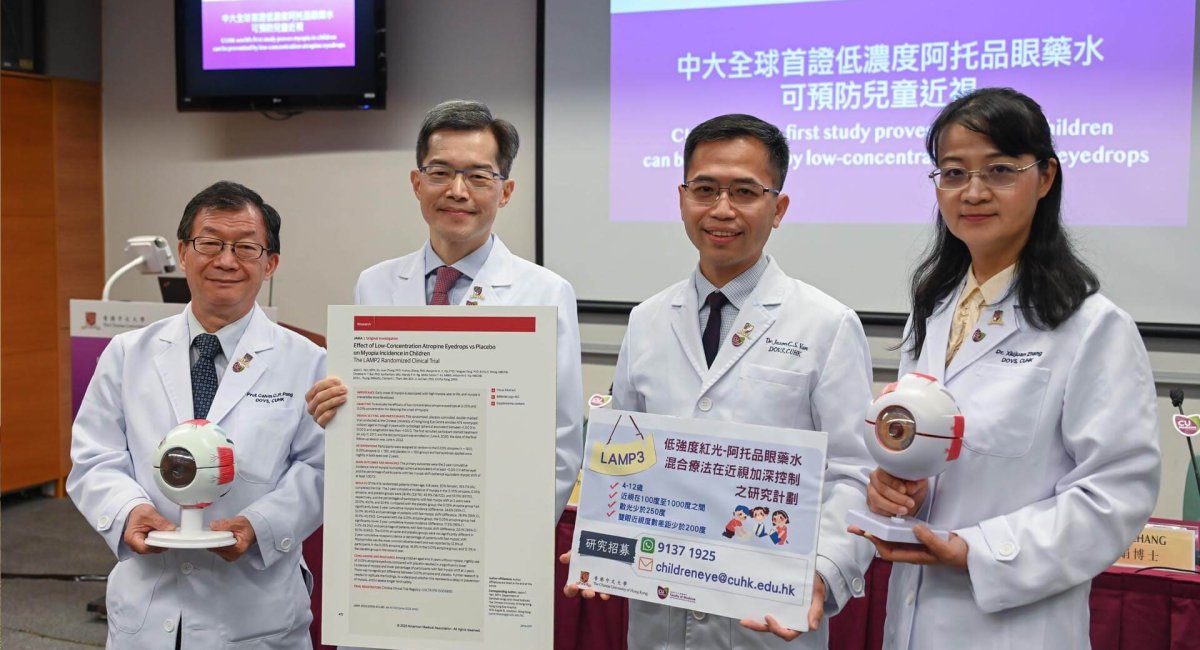The Department of Ophthalmology and Visual Sciences of The Chinese University of Hong Kong (CUHK)′s Faculty of Medicine (CU Medicine) conducted a randomised, placebo-controlled, double-masked trial of low-concentration atropine eyedrops to evaluate their effectiveness in preventing myopia. Results show that among children aged four to nine years without myopia, compared with placebo, nightly use of low-concentration 0.05% atropine eyedrops resulted in a significant reduction in the incidence of myopia over two years, from 53.0% to 28.4% (a relative reduction of 46.4%). This is the first study in the world to prove that low-concentration atropine eyedrops can prevent the onset of myopia. Details of the study have been published in the renowned medical publication The Journal of the American Medical Association (JAMA).
Myopia is a worldwide public health threat, with the highest prevalence in East Asia
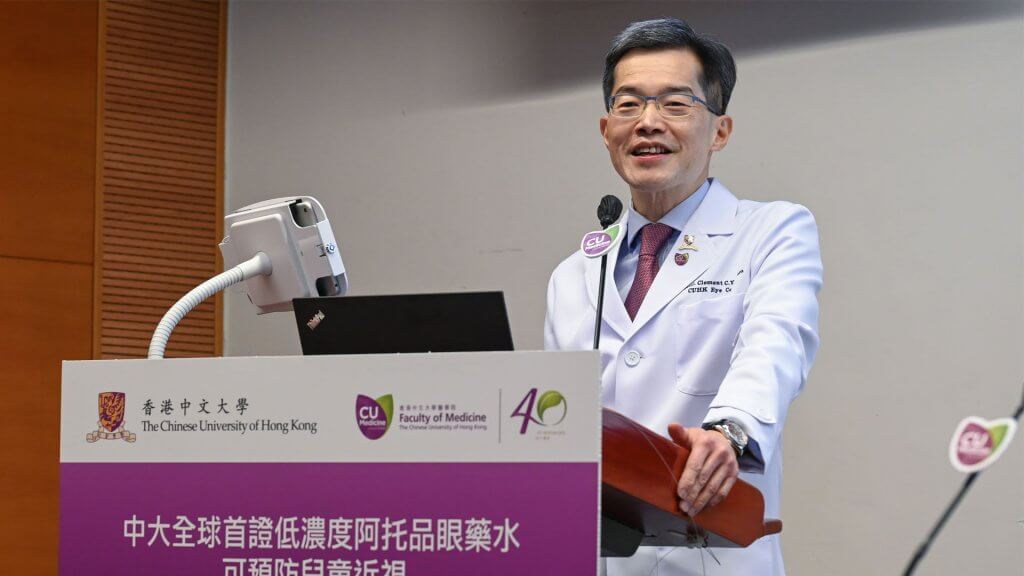
Myopia is a worldwide public health threat with increasing prevalence across many regions in recent decades. A study published by the American Academy of Ophthalmology predicted that approximately half of the world′s population will be myopic by 2050, with the highest prevalence in East Asia, the region that includes Hong Kong. Prof Clement CY THAM, Chairman and S. H. Ho Professor of Ophthalmology and Visual Sciences from the Department of Ophthalmology and Visual Sciences at CU Medicine, remarked, ″The increasing prevalence of myopia concerns many countries. For example, the Central Government in the Mainland aims to set up a mechanism covering all counties and districts across the country by the end of 2025 that can track myopia rates among youngsters and detect the factors that influence them. In Hong Kong, we have noticed that the COVID-19 pandemic has triggered a myopia boom in school children due to school closure and social distancing measures. Strategies to prevent myopia onset and to reduce its progression have become paramount.″
Early onset of myopia leads to an increased risk of high myopia and many sight-threatening conditions
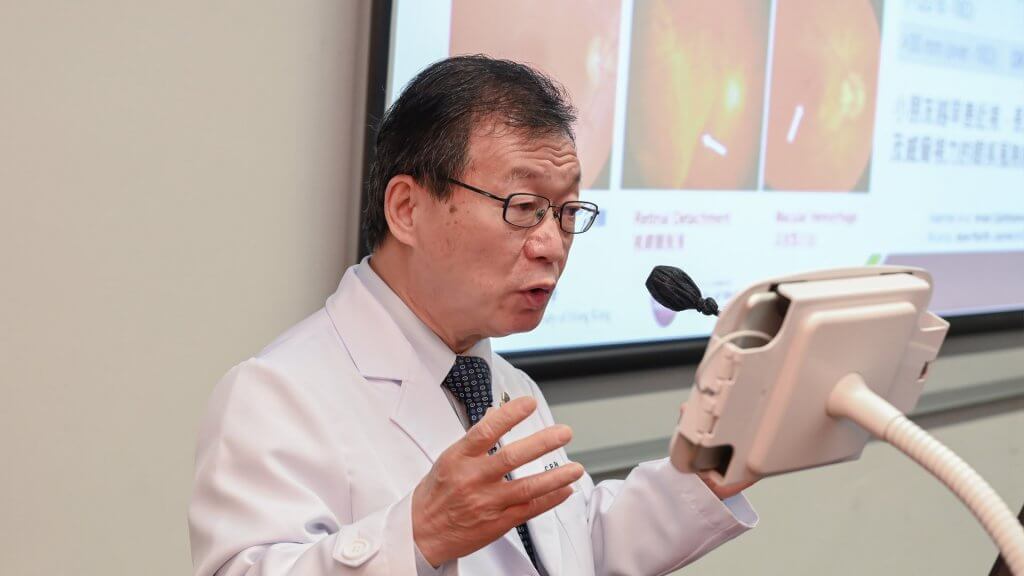
Myopic individuals have a higher risk of sight-threatening complications that lead to poor vision and even blindness. ″Myopia can be caused by excessive elongation of the eyeball,″ said Prof Calvin CP PANG, S. H. Ho Research Professor of Visual Sciences from the Department of Ophthalmology and Visual Sciences at CU Medicine and Director of the Shantou University / The Chinese University of Hong Kong Joint Shantou International Eye Centre. ″This disease is irreversible once it has developed and the earlier its onset, the greater the likelihood of high myopia occurring later in life. Glaucoma, macular degeneration, retinal detachment and cataracts are all complications of high myopia. The eyeball elongation problem cannot be corrected by wearing glasses or having laser refractive surgery, and thus the risk of complications cannot be reduced. Therefore, prevention or delay of myopia onset should be given top priority.″
Additional myopia prevention strategies are warranted for high-risk children
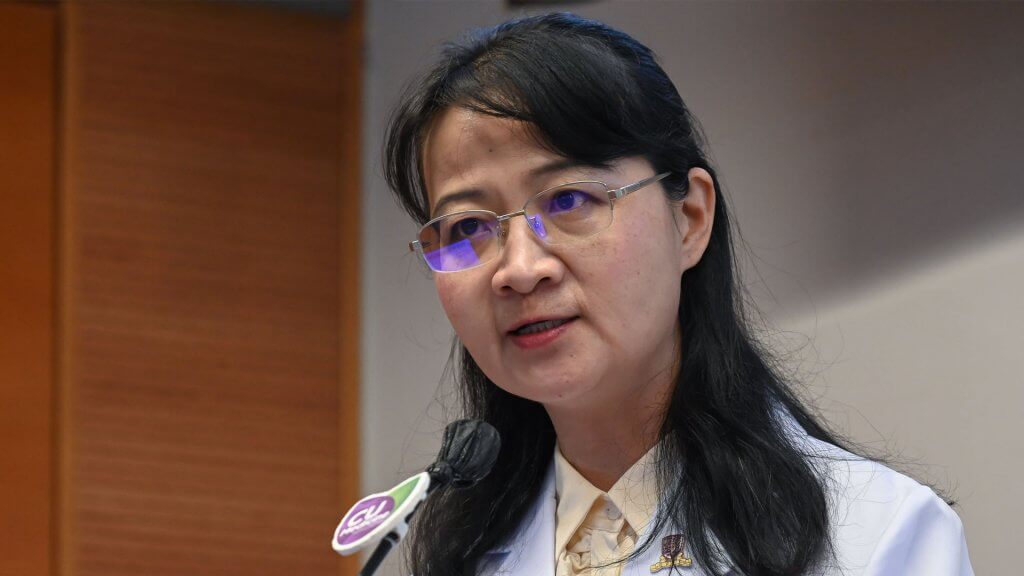
Studies have confirmed that the only way to prevent myopia and delay the myopia onset was to increase the time for outdoor activities. Dr ZHANG Xiujuan, Research Assistant Professor from the Department of Ophthalmology and Visual Sciences at CU Medicine, said, ″In a previous trial conducted in Mainland China, increasing outdoor class time by 40 minutes daily was proven to reduce the three-year cumulative incidence of myopia in children by 23%. Although encouraging children to spend more time outdoors is an effective approach, additional strategies are warranted, especially for children at high risk of developing myopia. Children whose parents are both myopic, have 12 times the risk of developing myopia compared to those whose parents are nonmyopic.″
Low-concentration atropine eyedrops can prevent myopia in children
The research team from the Department of Ophthalmology and Visual Sciences of CU Medicine recruited 474 nonmyopic children aged four to nine years at the CUHK Eye Centre to join the randomised, placebo-controlled, double-masked ″Low-Concentration Atropine for Myopia Prevention (LAMP2)″ trial from 2017 to 2020. The participants had at least one parent who is myopic. They were randomly assigned to the 0.05% atropine group, the 0.01% atropine group, or the placebo group and had eyedrops applied once nightly in both eyes for two years.
Results showed that the 0.05% atropine group had a significantly lower two-year cumulative incidence of myopia and a lower percentage of participants with fast myopic shift, compared with the placebo group (see details in Table 1).
Table 1: Key results of the LAMP2 study
| 0.05% Atropine group | 0.01% Atropine group | Placebo group | |
| Two-year cumulative incidence of myopia | 28.4% | 45.9% | 53.0% |
| Percentage of participants with fast myopic shift at two years | 25.0% | 45.1% | 53.9% |
| Percentage of participants reporting photophobia (the most common adverse reaction) |
12.9% | 18.9% | 12.2% |
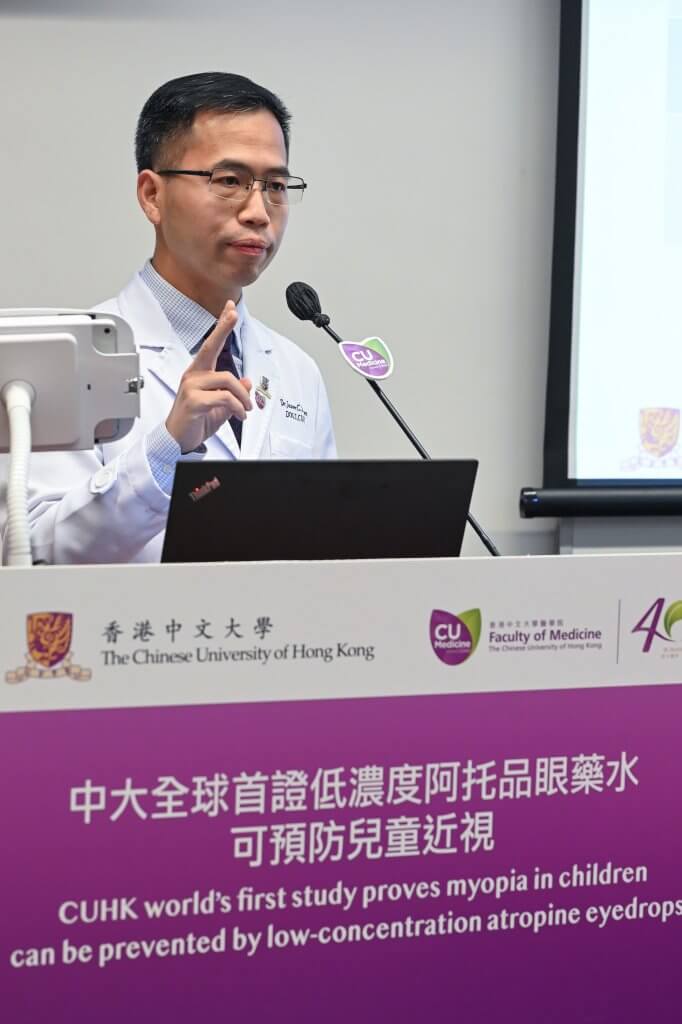
Dr Jason CS YAM, Principal Investigator of the LAMP2 study, Associate Professor from the Department of Ophthalmology and Visual Sciences, CU Medicine and Director of the CUHK Jockey Club Myopia Prevention Programme, stated, ″Our previous LAMP1 study proved that low-concentration atropine eyedrops can reduce myopia progression and a 0.05% concentration appeared to achieve the best balance between maximising efficacy and minimising side effects. The current LAMP2 study has further shown their potential in preventing myopia onset. As our younger generation becomes more reliant on digital devices and we are facing a surge in myopia in the future, our findings suggest low-concentration atropine eyedrops is an effective preventive strategy for myopia onset among high-risk children and reduce their risk of suffering from sight-threatening diseases.″
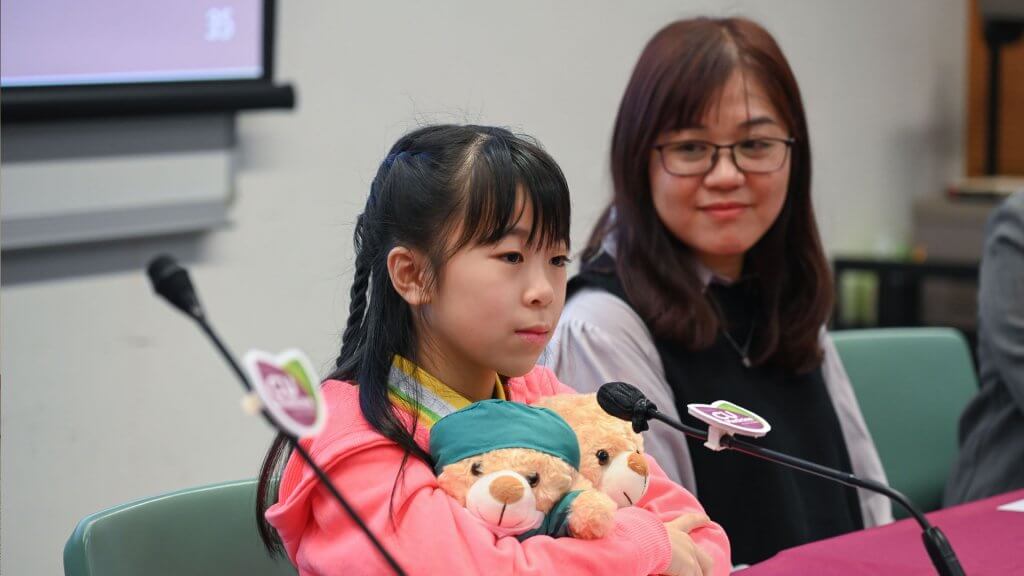
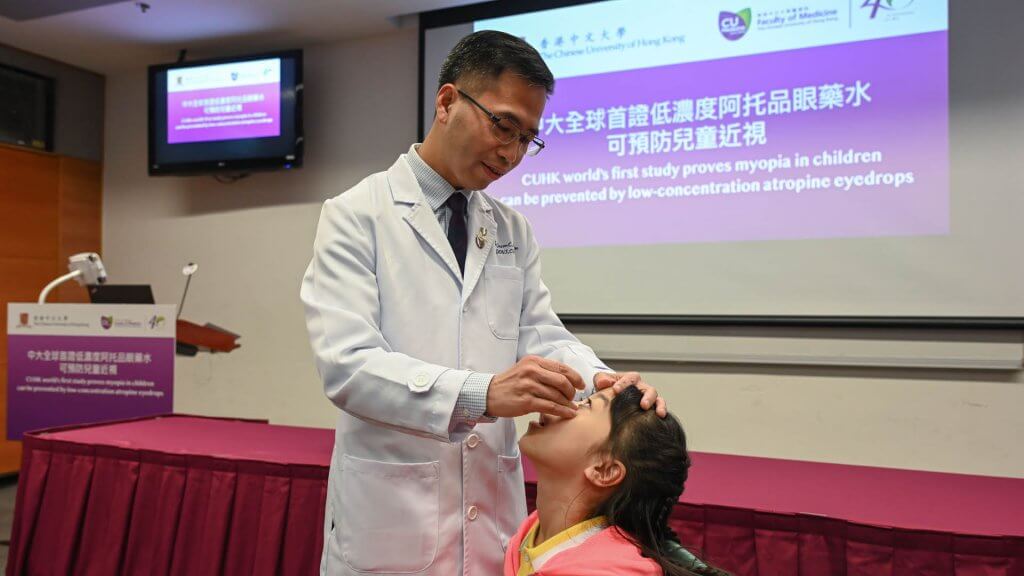
The team plans to launch a LAMP3 study to investigate the efficacy and safety of combining atropine eyedrops with red light therapy. Interested individuals can contact the research team by WhatsApp (91371925) or email (childreneye@cuhk.edu.hk).
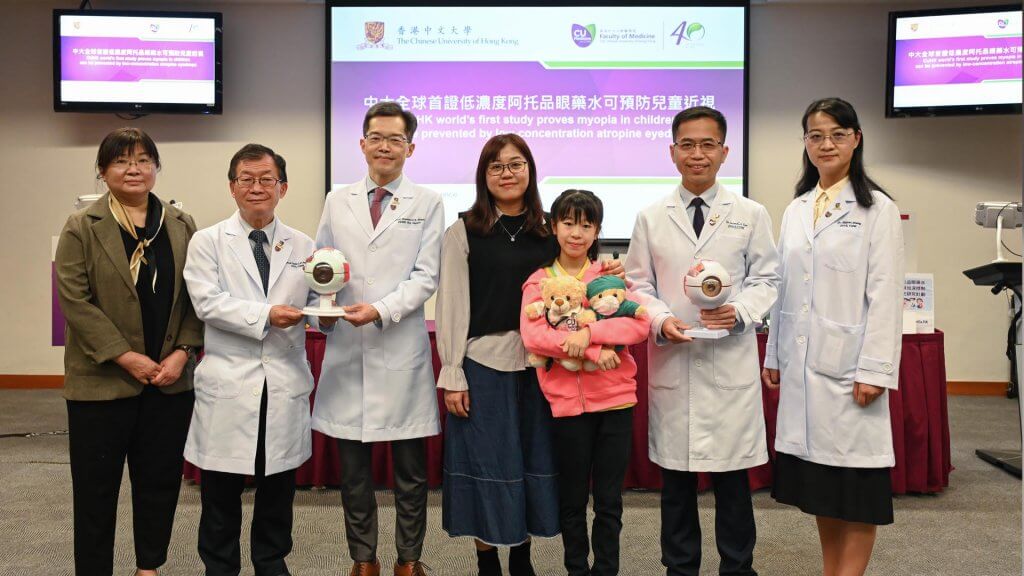
2023年3月13日
任卓昇醫生的團隊首證低濃度阿托品眼藥水可預防兒童近視
香港中文大學(中大)醫學院眼科及視學科學學系對低濃度阿托品眼藥水進行了一項隨機、安慰劑對照和雙盲研究,以評估其預防近視的功效。結果顯示,在四至九歲沒有近視的兒童中,與安慰劑相比,每晚使用低濃度0.05%阿托品眼藥水可使近視發生率顯著降低,於2年期間由53.0%減至28.4%(相對減少46.4%)。這是全球首個研究證實低濃度阿托品眼藥水可以預防近視,研究詳情已在著名的《美國醫學會雜誌》(JAMA)發表。
近視問題威脅全球公共衞生 以東亞地區發病率最高
近視問題威脅全球公共衞生,多個地區的近視發病率於過去數十年不斷上升。一份由美國眼科學會刊登的研究預測2050年全球將有近半人口患上近視,其中東亞地區(包括香港)的近視率最高。中大醫學院眼科及視覺科學學系系主任兼何善衡眼科及視覺科學講座教授譚智勇教授表示:「近視率上升的問題引起多國關注。以內地為例,中央政府目標在2025年建立一個能覆蓋全國所有縣區的機制,追蹤青少年的近視率及檢測相關影響因素。而在香港,我們留意到在新冠疫情下,學童因網課和社交活動受限制,近視率呈爆發式增長。故此,預防近視出現和減緩其加深速度的預防手段至關重要。」
早發近視增加罹患深近視和其他威脅視力的眼疾風險
近視者會有較高風險罹患威脅視力的眼疾,導致視力減弱,甚至失明。中大醫學院眼科及視覺科學學系何善衡視覺科學研究講座教授兼汕頭大學・香港中文大學聯合汕頭國際眼科中心院長彭智培教授解釋:「近視可以由眼球過長引起,一旦出現就不能逆轉,而且愈早發病,往後出現深近視問題的可能性就會愈大,青光眼、黃斑病變、視網膜脫落和白內障等相關併發症的發生率也愈高。這些疾病都可導致嚴重視力障礙,甚至致盲。值得注意的是,配戴眼鏡或接受激光矯視手術均無法矯正眼球過長問題。換言之,矯視方法無助減低出現近視相關併發症的風險。故此,我們需要將預防或延緩近視發病的工作放在首位。」
高風險患近視的兒童需要採取額外的預防策略
目前經研究證實唯一可以預防近視和延緩近視出現的方法就是增加戶外活動時間。中大醫學院眼科及視覺科學學系研究助理教授張秀娟博士表示:「過往一項在內地進行的研究顯示,每日增加戶外活動時間40分鐘,能夠減低兒童近視的三年發病率23%。雖然鼓勵兒童多花時間在戶外活動是一種有效的預防方法,但額外的預防策略仍然重要,尤其是對於高風險患近視的兒童。父母都患有近視的兒童患上近視的風險,是父母均沒有近視的兒童的12倍。」
低濃度阿托品眼藥水可預防兒童近視
有見及此,中大醫學院眼科及視學科學學系的研究團隊於2017年至2020年在中大眼科中心招募474名四至九歲的非近視兒童,參與隨機、安慰劑對照及雙盲的低濃度阿托品眼藥水預防近視(簡稱「LAMP2」)研究。參與者的父母至少有一位是近視患者。這些兒童被隨機分配到0.05% 阿托品組、0.01% 阿托品組和安慰劑組,並在兩年內每晚對雙眼滴一次眼藥水。結果顯示,0.05% 阿托品組的兩年累積近視發病率和出現快速近視偏移傾向(fast myopic shift)的參與者百分比,均明顯地較安慰劑組低(詳細數據見表一)。
表一:LAMP2研究主要結果
| 0.05% 阿托品眼藥水組 |
0.01% 阿托品眼藥水組 |
安慰劑組 | |
| 兩年累積近視發病率 | 28.4% | 45.9% | 53.0% |
| 兩年間出現快速近視偏移的參與者比率 | 25.0% | 45.1% | 53.9% |
| 出現畏光問題的參與者比率 (畏光是最常見的副作用) |
12.9% | 18.9% | 12.2% |
LAMP2 研究首席研究員、中大醫學院眼科及視覺科學學系副教授兼「香港中文大學賽馬會瞳心童行計劃」總監任卓昇醫生表示:「我們之前的 LAMP1 研究已經證明,低濃度阿托品眼藥水可以減緩近視加深,0.05%濃度的眼藥水療效最大且副作用少。這一次的 LAMP2 研究進一步顯示了這款低濃度眼藥水應用在預防近視方面的潛力。隨著年輕一代對電子產品的依賴程度愈來愈高,社會未來將面臨近視激增的情況。我們的研究結果顯示,低濃度阿托品眼藥水為有效的方法預防兒童近視,並最終降低他們患上威脅視力眼疾的風險。」
研究團隊將開展 LAMP3 研究,以研究阿托品眼藥水結合紅光療法的療效和安全性。有興趣人士可以WhatsApp (91371925) 或電郵(childreneye@cuhk.edu.hk)聯繫研究團隊。

